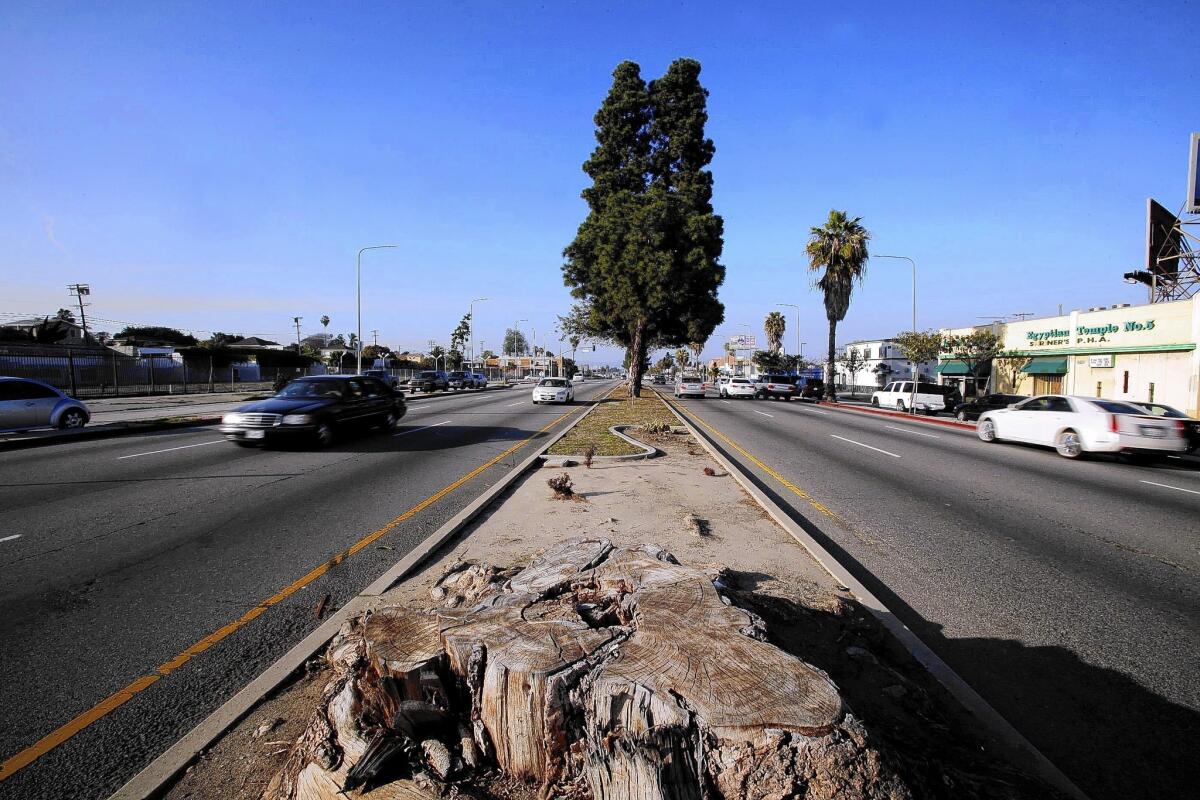Tree removal along Crenshaw has residents stumped

- Share via
In the name of civic progress, the Crenshaw corridor has lost a lot of trees.
First, to clear the way for the space shuttle Endeavour’s trek to the California Science Center, 71 mature magnolias and pines were chopped down in 2012 along an almost two-mile stretch in South Los Angeles. Now, with the construction of the Crenshaw/LAX subway line, residents are bracing for more.
About 175 trees — a third of those remaining — are expected to be cut down along Crenshaw Boulevard during the light-rail project, according to the Metropolitan Transportation Authority. That number could climb as contractors tweak the design.
“South Los Angeles, in general, is short on street trees,” said Malcolm Carson, general counsel and policy director with the nonprofit Community Health Councils. “So the idea that we’re losing trees that are so valued … that take decades to grow, at a time when we are really trying to increase the tree canopy in our communities, it’s really a bad situation.”
City officials, who hope the Crenshaw/LAX line will bring economic development, admitted the corridor will be unsightly during the construction — much like a home undergoing renovation. But, they said, an aesthetically cohesive boulevard will emerge from the destruction.
“Change is hard,” said Karly Katona, deputy for environmental sustainability for Los Angeles County Supervisor Mark Ridley-Thomas. “But the status quo is unacceptable for us. The community has waited for this [rail system] for a very long time.”
All along this portion of Crenshaw Boulevard, large stumps remain where trees once stood tall.
When the California Science Center first won approval to remove 400 trees in Westchester, Inglewood and other South L.A. communities, angry Crenshaw residents threatened to halt the shuttle’s move. During negotiations, officials agreed to plant four times as many trees in the neighborhood as they had removed, once Endeavour was safely in place. Other affected areas were to receive two trees for every one cut down.
So far, just 10 new trees have been planted in vacant spots along the corridor. Any beyond that, officials said, would have to be removed again during light-rail construction.
The MTA has been holding monthly discussions and participating in weekly community meetings to keep residents informed about the project. During one of those sessions in late January, officials detailed plans to extract 119 trees on Crenshaw — between Exposition Boulevard and 48th Street — to make room for three station platforms.
That number came as a surprise to Carson and others in the community, who said removal along that section of the boulevard had not been spelled out in the environmental impact report. Fifty-six trees also are slated to be taken out of medians to the south, between 48th and 67th streets.
MTA officials have voiced a commitment to planting twice as many trees after most of the first two phases of the project is completed by late 2017. But negotiations with the Science Center, many residents said, have left them skeptical.
“It disturbs me that they are taking the trees away,” said Clarence R. Williams, who lives in Leimert Park. “The wonderful thing about this particular area of L.A. is that it had a lushness … but it lost its mystique and is sterile.”
In the MTA’s view, it is unfair to compare the shuttle and light-rail situations.
“There is a big difference between what we are doing,” said Charles Beauvoir, MTA’s Crenshaw/LAX project director. “We are making a $2-billion investment in the community. We have bent over backward to make this work.”
Ed Johnson, assistant chief deputy to City Councilman Herb Wesson, who represents the area, understands the frustration of residents who fear their neighborhood will be left a concrete jungle. But he is asking for patience.
“We have worked so hard to get the line and the stations,” Johnson said. “Hopefully, we can get past this and have a beautiful line and beautiful community.”
More to Read
Sign up for Essential California
The most important California stories and recommendations in your inbox every morning.
You may occasionally receive promotional content from the Los Angeles Times.














